Tropical Fish Species
There are thousands of pet fish species that are common in the aquarium trade, so this list will be ever-growing. The information here is from credible sources, written by aquarium fish hobbyists and long time aquarium keepers. New tropical fish species information will be included here, from freshwater fish, to cichlids, bottom feeders, brackish fish, invertebrates and more.
Reference this useful aquarium fish descriptions list with the facts that you need to have a successful tropical fish aquarium.
If you are looking for information on Koi fish, the most popular pond fish or Gold Fish, we have created a page entirely devoted to these unique tropical fishes.
Also see our page on the ever popular first timer's fish, the siamese fighting fish also called the Betta fish and the large and personable Oscar fish.
Bleeding Heart Tetras
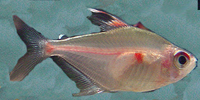 Bleeding heart tetras are a peaceful and active schooling fish that will school with other species of tetra and continuously occupy every area of the tank. An excellent and hardy addition to any freshwater aquarium. Bleeding Heart Tetras do best when kept in a school of at least three, they tend to be shy when kept alone. An excellent community fish and can be kept with semi aggressive species as long as they are in a school with other tetras, either other bleeding heart tetras or other similar tetra fish species.
Bleeding heart tetras are a peaceful and active schooling fish that will school with other species of tetra and continuously occupy every area of the tank. An excellent and hardy addition to any freshwater aquarium. Bleeding Heart Tetras do best when kept in a school of at least three, they tend to be shy when kept alone. An excellent community fish and can be kept with semi aggressive species as long as they are in a school with other tetras, either other bleeding heart tetras or other similar tetra fish species. Maximum size: 2.25 inches - Average size: 1 inch
Sex differences: Females are more rounded then males and have a short dorsal fin. The male Bleeding Heart Tetra has a pointed and elongated dorsal fin.
Dwarf Gouramis
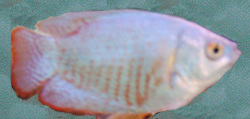 Dwarf Gouramis are a shy, slow moving yet beautiful fish. These small Dwarf Gouramis are territorial but non-aggressive. You'll find them living near the surface or the middle in the same spot in your aquarium most of the time. They can live in a school or by themselves. They get along with other fish but avoid including Dwarf Gouramis in an aquarium with fast moving aggressive fish because they easily become stressed. Be sure to include tall plants that reach near the surface for them to take cover in.
Dwarf Gouramis are a shy, slow moving yet beautiful fish. These small Dwarf Gouramis are territorial but non-aggressive. You'll find them living near the surface or the middle in the same spot in your aquarium most of the time. They can live in a school or by themselves. They get along with other fish but avoid including Dwarf Gouramis in an aquarium with fast moving aggressive fish because they easily become stressed. Be sure to include tall plants that reach near the surface for them to take cover in. Maximum size: 2 inches - Average size: 2 inches
Sex differences: Females are less colorful then males and their dorsal fins are rounded whereas the male Dwarf Gourami has pointed dorsal fins.
Ruby Barbs
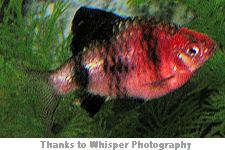 Ruby Barbs are very active and occupy the whole tank area, top middle and bottom. Their colors are brilliant and dazzle making them a colorful and noticeable freshwater fish, perfect for adding life and color to the tropical aquarium. Ruby Barbs are compatible with other barbs and similar semi aggressive fish, they do not have overly aggressive tenancies but they can be somewhat territorial. They will nip the fins of slower moving fish. Due to their high activity levels, a larger aquarium is recommended. Ruby barbs are very hardy fish and a good addition to the semi aggressive and fast-moving tropical fish aquarium.
Ruby Barbs are very active and occupy the whole tank area, top middle and bottom. Their colors are brilliant and dazzle making them a colorful and noticeable freshwater fish, perfect for adding life and color to the tropical aquarium. Ruby Barbs are compatible with other barbs and similar semi aggressive fish, they do not have overly aggressive tenancies but they can be somewhat territorial. They will nip the fins of slower moving fish. Due to their high activity levels, a larger aquarium is recommended. Ruby barbs are very hardy fish and a good addition to the semi aggressive and fast-moving tropical fish aquarium.Maximum size: 2.25 inches - Average size 1.25 inches
Sex differences: Ruby Barb females have only partially black dorsal fins, only half of the fin is black. Males have all black dorsal fins and reddish colored pelvic fins.
Plecostomus
 The Plecostomus, also known as a Suckermouth Catfish or Pleco is a bottom feeding, algae eating fish. The Suckermouth is very interesting to watch when it is active, swimming about the tank sucking on to everything. At other times, these tropical fish are very shy and will hide. Adequate hiding spaces are necessary as is a larger aquarium because they can get quite large. Plecostomus grow very slowly so a small tank is fine as long as they will eventually be moved into a larger tank. The algae eating plecostomus is a solitary freshwater fish that is fine with or without other fish. Do not introduce a plecostomus into a newly set up tank for they need an established aquarium with algae, moss and other natural nutrients. Substitute algae wafers into their diet so they do not starve once the algae has been eaten.
The Plecostomus, also known as a Suckermouth Catfish or Pleco is a bottom feeding, algae eating fish. The Suckermouth is very interesting to watch when it is active, swimming about the tank sucking on to everything. At other times, these tropical fish are very shy and will hide. Adequate hiding spaces are necessary as is a larger aquarium because they can get quite large. Plecostomus grow very slowly so a small tank is fine as long as they will eventually be moved into a larger tank. The algae eating plecostomus is a solitary freshwater fish that is fine with or without other fish. Do not introduce a plecostomus into a newly set up tank for they need an established aquarium with algae, moss and other natural nutrients. Substitute algae wafers into their diet so they do not starve once the algae has been eaten.Maximum size: 15 inches and beyond, depending on the exact species - Average size 3-5 inches
Sex differences: The plecostomus male and female differences are indistinguishable.
Mollies
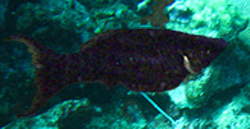 There are many species of mollies, including the black molly, sailfin molly, balloon molly and silver molly. Mollies are not freshwater fish, but brackish fish meaning they require a small salt concentration in their habitat. Add a teaspoon of freshwater aquarium salt every water change. Be careful not to add too much salt because it does not evaporate and the salt concentrations will be too high. Mollies are good brackish community fish but they survive longer and are healthier in a brackish aquarium, not a tropical aquarium. They are a lively schooling fish that needs other species of Molly to school with. The other fish do not have to be the exact same species because they will school with similar species. All species of Mollies get very nervous and shy when alone.
There are many species of mollies, including the black molly, sailfin molly, balloon molly and silver molly. Mollies are not freshwater fish, but brackish fish meaning they require a small salt concentration in their habitat. Add a teaspoon of freshwater aquarium salt every water change. Be careful not to add too much salt because it does not evaporate and the salt concentrations will be too high. Mollies are good brackish community fish but they survive longer and are healthier in a brackish aquarium, not a tropical aquarium. They are a lively schooling fish that needs other species of Molly to school with. The other fish do not have to be the exact same species because they will school with similar species. All species of Mollies get very nervous and shy when alone. Maximum size: 2.5 - 3.5 inches depending on the species - Average size: 1 - 1.5 inches
Sex differences: Females are more rounded then males and the males have a small anal fin and female Mollies do not.
Neon Tetras
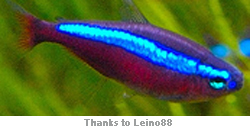 Neon tetras are a peaceful and active schooling fish that will occupy every area of the tank. An beautiful addition to any freshwater aquarium. Neon Tetras are not as hardy as most assume. Never add Neons to a new aquarium. They need the biological properties of an established freshwater aquarium. They must be in a school of at least 3 but more is preferred. Neon Tetras are easily stressed and they feel safe when in a school. They will school with Cardinal Tetras which are very similar to the Neon Tetra. Due to their small size, a strong filter is not recommend because you might find a Neon Tetra sucked against the filter intake! These freshwater fish are a delicate species but a very peaceful community fish that is easily kept with other similar small tropical fish.
Neon tetras are a peaceful and active schooling fish that will occupy every area of the tank. An beautiful addition to any freshwater aquarium. Neon Tetras are not as hardy as most assume. Never add Neons to a new aquarium. They need the biological properties of an established freshwater aquarium. They must be in a school of at least 3 but more is preferred. Neon Tetras are easily stressed and they feel safe when in a school. They will school with Cardinal Tetras which are very similar to the Neon Tetra. Due to their small size, a strong filter is not recommend because you might find a Neon Tetra sucked against the filter intake! These freshwater fish are a delicate species but a very peaceful community fish that is easily kept with other similar small tropical fish. Maximum size: 1.25 inches - Average size: .75 inch
Sex differences: Female Neon Tetra has a rounded, more bulky belly then the male.
Swordtails
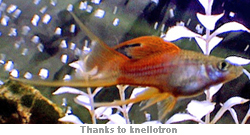 There are many species of Swordtails including the Lyretail swordtail, and the Green Swordtail. Also known as Swords, these live-bearing fish are a peaceful community fish. Swordtails are not the hardiest of tropical fish, they need good water quality but they are easy to care for if this condition is met. Be sure to do your proper water changes in your aquarium. Swordtails are a schooling fish, but they do not form tight schools. Regardless, they need to be with other Swordtails, mixing species together is fine. They can live on their own but are less stressed and more active when they are mixed with other live bearers, including other Swordtails and Platies. Swordtails can be kept with most freshwater fish but avoid overly aggressive fish.
There are many species of Swordtails including the Lyretail swordtail, and the Green Swordtail. Also known as Swords, these live-bearing fish are a peaceful community fish. Swordtails are not the hardiest of tropical fish, they need good water quality but they are easy to care for if this condition is met. Be sure to do your proper water changes in your aquarium. Swordtails are a schooling fish, but they do not form tight schools. Regardless, they need to be with other Swordtails, mixing species together is fine. They can live on their own but are less stressed and more active when they are mixed with other live bearers, including other Swordtails and Platies. Swordtails can be kept with most freshwater fish but avoid overly aggressive fish. Maximum size: 3.5 inches depending on the species Average size: 2 inches
Sex differences: Males have the very obvious pronounced sword on the bottom of their tail. Females have only a tiny spike on their tail.